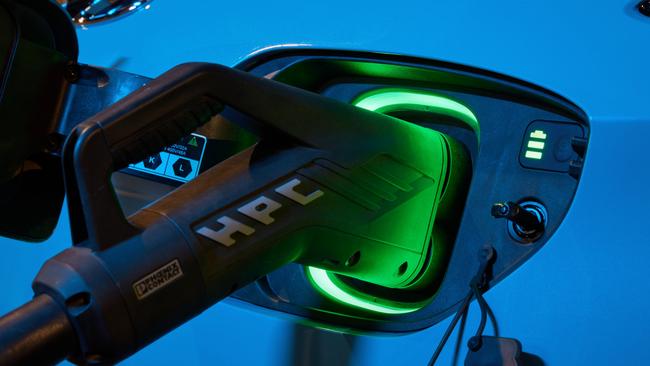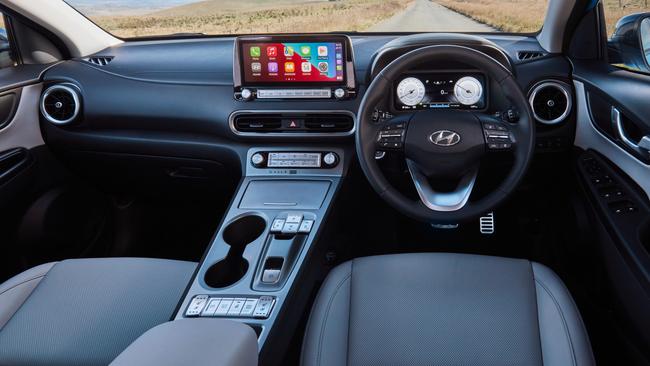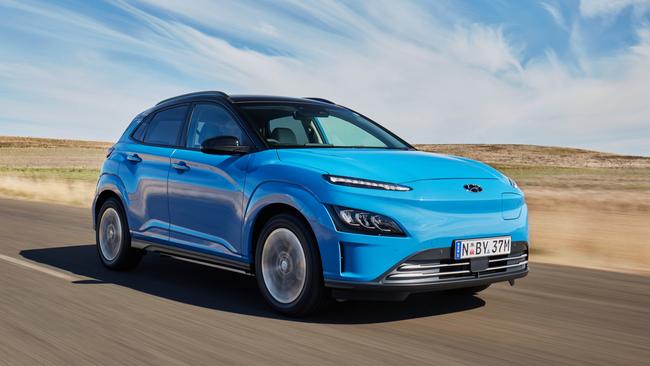Hyundai Kona Electric beats the bowser blues with solar power
When unleaded prices pushed toward $2, solar power helped the Hyundai Kona Electric deliver cheap family motoring.
Business
Don't miss out on the headlines from Business. Followed categories will be added to My News.
Skyrocketing petrol prices could provide the impetus to kickstart Australia’s shift to electric vehicles.
While halving the fuel excise burden for six months has begun to flow through at the petrol pump, when prices pushed through the $2 a litre barrier buyers talked with their clicks.
Online searches for battery electric vehicles have surged. But it’s not just fuel prices inspiring budget-conscious consumers to seek alternatives – rising energy prices and household costs are also taking hold.
So how much does it cost to run an electric vehicle?
Ultimately, it depends on your electricity retailer, whether you have solar at home and when you’re able to charge.
During recent months we’ve been testing a Hyundai Kona Electric Highlander to evaluate the real-world investment to run an EV.
With a drive-away price of about $65,600, this extended range top-shelf version of the popular SUV is expensive – but offers one of the best electric experiences currently on the market.
Apart from the distinctive closed grille, it looks like the traditional Kona. Under the skin is a 150kW motor with a 64kWh battery under the floor.

Most buyers would pay about $1500 to install a fast charger but with robust organisation we’ve managed with the traditional 10-amp power point in the garage. At home we’ve installed a 5kW solar system with 21 panels on the roof.
Being late to the solar party means the days of generous buyback tariffs are gone, so the most efficient way of obtaining savings is using the electricity generated by the sun.
When plugged in, the Kona charging consumes about 2200 watts of power.
The dash display features the battery’s percentage of charge and how long it will take to reach capacity at the current rate of input.
The average cost of electricity in Queensland is about 21c a kilowatt hour. At that price, compared to petrol at $1.60 a litre, you’d save nearly $3000 annually.
Using our solar system and charging during the day, that cost diminishes. At peak times the system is generating 5000 watts, with about 2000 going back into the grid.
Most EVs use about 1kWh for every 5-6km travelled.

During our test, the Kona has been delivering about 13kWh/100km. Taking the daily electricity charges into account and charging while solar power is at its peak, that would bring the charging cost down to about 5c/kWh – 65c for every 100km.
Servicing costs are cheaper than petrol models due to having fewer moving parts.
Other savings are also achieved through less expensive registration.
The Kona also boasts better performance than petrol-powered models.
It has a rapid response off the line with nearly 400Nm of torque at the ready from standstill – and the acceleration for overtaking is punchy.

Although it’s not all roses.
There remains a lot of work to be done on infrastructure to support electric vehicles. Long-distance travel still requires careful planning. While the Kona has a range of nearly 500km, road trips require analysis of charging facilities at the destination and along the route.
Also, Queensland last month announced a $3000 tax credit on an electric vehicle purchase, matching similar policies in NSW and Victoria, but the federal government has ruled out financial support.
But the kicker for the Smart State is it’s only for vehicles up to the value of $58,000.
Charging time can also be an annoyance. Use the standard power point and you’re looking at about 24 hours from 10 per cent to full. A home fast-charger should do the same job in about nine hours – but use a rapid 100kW unit and it will replenish the battery from zero to 100 per cent in an hour.





